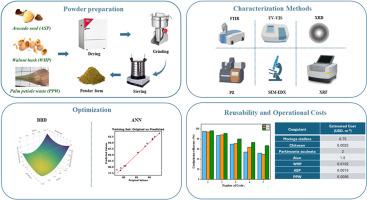Sustainable hexavalent chromium removal from aqueous solutions using novel plant-based biocoagulants: Comparative performance, mechanism elucidation, and economic evaluation
IF 5.8
2区 化学
Q2 CHEMISTRY, MULTIDISCIPLINARY
引用次数: 0
Abstract
This study evaluates the effectiveness of three natural biocoagulants; walnut husk powder, avocado seed powder, and palm petiole waste for removing hexavalent chromium from aqueous solutions. Key operational parameters, including pH, coagulant dose, and particle size, were optimized using the Box-Behnken design. The biocoagulants-flocculants were comprehensively characterized before and after treatment using techniques such as XRD, FTIR, XRD, SEM-EDX, and ZP measurements to elucidate the mechanisms of chromium removal. Under optimized conditions, all biocoagulants-flocculants demonstrated significant removal efficiencies: walnut husk powder (92.47 %), avocado seed powder (ASP, 94.09 %), and palm petiole waste (PPW, 98.56 %). Cost analysis identified ASP as the most economical option, with a treatment cost of 0.0015 USD/m3. Reusability studies revealed that PPW retained the highest performance over multiple cycles, achieving 66.81 % removal efficiency after five reuse cycles. These findings highlight the efficacy, mechanisms, and scalability of these biocoagulants-flocculants as sustainable solutions for hexavalent chromium removal in water treatment applications.

使用新型植物基生物混凝剂从水溶液中可持续去除六价铬:比较性能、机制阐明和经济评估
本研究评价了三种天然生物混凝剂的有效性;从水溶液中去除六价铬的核桃壳粉、鳄梨籽粉和棕榈叶柄废。使用Box-Behnken设计优化了关键操作参数,包括pH值、混凝剂剂量和粒径。采用XRD、FTIR、XRD、SEM-EDX、ZP等技术对处理前后的生物混凝絮凝剂进行了综合表征,阐明了除铬机理。在优化条件下,核桃壳粉(92.47%)、鳄梨籽粉(ASP, 94.09%)和棕榈叶柄渣(PPW, 98.56%)的生物混凝-絮凝剂去除率均较好。成本分析表明,ASP是最经济的选择,处理成本为0.0015美元/立方米。可重用性研究表明,PPW在多个循环中保持了最高的性能,在5个重复使用循环后达到66.81%的去除效率。这些发现突出了这些生物混凝剂-絮凝剂作为水处理应用中六价铬去除的可持续解决方案的功效、机制和可扩展性。
本文章由计算机程序翻译,如有差异,请以英文原文为准。
求助全文
约1分钟内获得全文
求助全文
来源期刊

Sustainable Chemistry and Pharmacy
Environmental Science-Pollution
CiteScore
8.20
自引率
6.70%
发文量
274
审稿时长
37 days
期刊介绍:
Sustainable Chemistry and Pharmacy publishes research that is related to chemistry, pharmacy and sustainability science in a forward oriented manner. It provides a unique forum for the publication of innovative research on the intersection and overlap of chemistry and pharmacy on the one hand and sustainability on the other hand. This includes contributions related to increasing sustainability of chemistry and pharmaceutical science and industries itself as well as their products in relation to the contribution of these to sustainability itself. As an interdisciplinary and transdisciplinary journal it addresses all sustainability related issues along the life cycle of chemical and pharmaceutical products form resource related topics until the end of life of products. This includes not only natural science based approaches and issues but also from humanities, social science and economics as far as they are dealing with sustainability related to chemistry and pharmacy. Sustainable Chemistry and Pharmacy aims at bridging between disciplines as well as developing and developed countries.
 求助内容:
求助内容: 应助结果提醒方式:
应助结果提醒方式:


